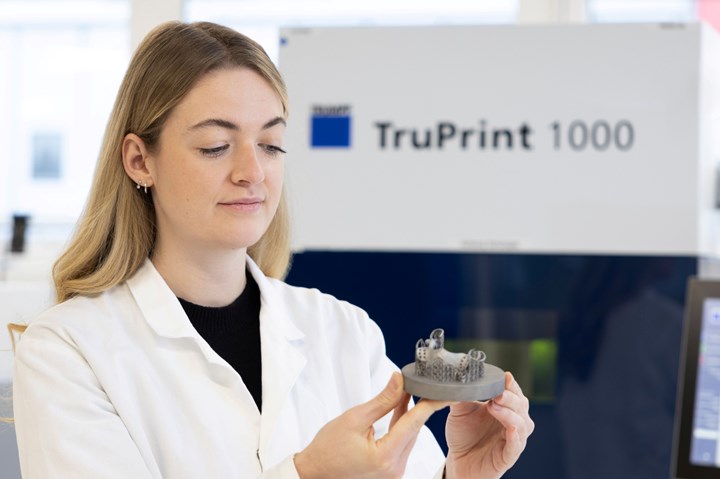Optimized 3D Printer Targets Dental, Medical Applications
The new Trumpf TruPrint 1000 offers faster print speeds, higher quality parts and requires less floor space.
The redesigned TruPrint 1000 system offers faster print speeds and higher-quality parts, and is well-suited for series production. Photo Credit, all images: Trumpf
Trumpf Inc. is introducing the new TruPrint 1000 for additive series production to the North American market. The productive and compact entry-level system for 3D additive processing of metal powders was redesigned for the manufacture of dental prostheses or medical technology but is also useful in R&D, small series production and for mold and die details where conformal cooling is beneficial. It is said to be two times faster than its predecessor.
The printer features two 200-watt lasers and a multiplate option, which enables users to run multiple builds without operator intervention by automatically exchanging the build plate; up to four build plates can be stacked. “The TruPrint 1000 can produce overnight or on weekends, running multiple jobs automatically without a worker having to be present,” Adam Simons, head of additive manufacturing sales & product at Trumpf, says.
A new compact design means the TruPrint 1000 only uses half of the floor space needed by previous editions and can pass easily through a standard door. Even in smaller production environments, users can have several machines producing side by side in parallel to further speed up series production.
With smaller floorspace requirements previous generations, the machine takes up little space and fits through a standard door.
An exchange kit, the build, powder and overflow cylinders are said to be quick and easy to change. A material change, such as from cobalt-chrome to titanium, can be completed in just 15 to 20 minutes. Brushes and gloves are integrated into the machine. The user can also clean the additively manufactured components and unpack the build job — without opening the door.
Trumpf also improved the flow of the shielding gas during the production process. “Thanks to the primary and secondary flow, the work area remains clean even after several build jobs and the protective glass does not become contaminated,” says Simons. “The same is true when processing tool steel, which can be prone to heavy fuming.”
The TruPrint 1000 works quickly and reliably. In the Multilaser version, the system has two lasers and both lasers can process the entire build plate, further improving productivity. The system also uses a beam expander to automatically adjust the spot diameter of the laser for the particular build job. The spot diameter is 55 or 80 μm, depending on the application. The wider spot enables higher productivity, while the 55-μm spot can be used when special powders need higher energy density.
Related Content
-
Maintaining a Wire EDM Machine
To achieve the ultimate capability and level of productivity from your wire EDM on a consistent, repeatable and reliable basis, regular maintenance is a required task.
-
Fundamentals of Designing the Optimal Cooling System
The right mold components can help improve mold cooling and thereby produce higher-quality parts.
-
Solving Mold Alignment Problems with the Right Alignment Lock
Correct alignment lock selection can reduce maintenance costs and molding downtime, as well as increase part quality over the mold’s entire life.

















